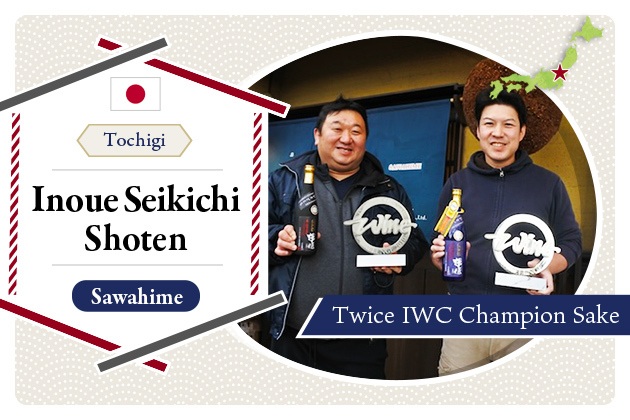
2022.07
14
Learning about yamahai yeast starter and yamahai sake
Many readers might have noticed the term "yamahai(山廃)" on the label when choosing a bottle. It is not easy to imagine what it means even if you know the kanji, especially with the association of the character "hai (廃, to abolish, to abandon)" that may be off-putting. This article will explain this obscure concept of yamahai, and familiarize the reader with its meaning, flavor, and benefits.
- What kind of sake is yamahai?
- A month of yamahai yeast starter making
- Day1: Ikemeshi ("buried" rice), shikomi (mashing), temoto (hand-mixing)
- Day 3-4: Utase (cooling)
- Day 5-12: Hatsudaki (first heating) to maedaki-kikan (preliminary heating stage)
- Day 13-18: Fukure (swelling), Wakitsuki (start of full-blown fermentation), wakitsuki-yasumi (end of heating stage)
- Day 19: Wake (cooling by dividing the mash)
- Day 21-: Karashi (conditioning period)
- Enjoying yamahai sake: Pair it with full-flavored dishes
- Summary
What kind of sake is yamahai?
First of all, yamahai is an abbreviation. The full term is "Yamaoroshi Haishi Moto." Yamahai is the sake made with the starter (moto) that abolishes (haishi) the step called yamaoroshi. Let’s take a closer look.
Overview of Yamahai
All sake is made with the base of shubo (moto), or yeast starter. Shubo includes sokujo-style and kimoto-style, and yamahai is a derivative of the kimoto-style starter.
Related article: What is shubo (yeast starter)?
Difference between yamahai and sokujo
The main difference between sokujo-style and kimoto-style starter, from which yamahai derives, is whether or not lactic acid is added.。Lactic acid is added to sokujo-style starter to raise acidity (lower the pH level), and build an environment unfavorable for unwanted bacteria to grow. Compared to kimoto-style starter, which we will discuss later, sokujo starter is shorter to create an environment beneficial for yeast to propagate and adverse for unwanted bacteria, which reduces the overall period for starter to complete to 10 to 14 days.
Sake made using the sokujo method is mainstream today, due to the minimal time and labor that it requires.
Difference between Yamahai and Kimoto
We may understand yamahai and kimoto as siblings, as both take advantage of natural lactic acid bacteria. Then what differentiates yamahai from kimoto? It is whether the process involves yamaoroshi; the very term yamahai has to do with this difference.
Up until 1910, when sokujo-style starter was developed, and adopted by many brewers, kimoto was the standard method. The traditional kimoto method that has continued since the Edo Period requires yamaoroshi, or mixing of the starter ingredients of water, steamed rice, and koji in shallow tubs (hangiri) with kai (paddle-like tool) many times a day. Yamaoroshi is the most labor- and time-consuming process in the kimoto starter making.
Yamahai is the starter-making method that abandoned this yamaoroshi. In this method, in place of yamaoroshi, a process called mizukoji is added. Mizukoji is made by adding and mixing koji into water, and letting enzymes from koji dissolve into the water by resting for a period of time.
In the Meiji Period, the National Research Institute of Brewing was established and scientific research of sake brewing was institutionalized. In 1909, the Institute’s engineer, Kinichiro Kagi focused on enzyme activities and invented “yamaoroshi haishi moto” with the use of mizukoji. Once the starters made by this yamaoroshi haishi moto and by kimoto were analyzed and their components were proven to be the same, it opened doors to an increasing number of breweries to adopt the yamahai method.
Yamahai is a method born out of a synthesis between the traditional kimoto method and the power of science.
A month of yamahai yeast starter making
Let’s look at the steps of the standard process of yamahai yeast starter making which spans as long as a month.
Day1: Ikemeshi ("buried" rice), shikomi (mashing), temoto (hand-mixing)
Ikemeshi ("buried" rice)
After rice is steamed, it is cooled slowly over a long time. This process is ikemeshi, which conditions rice to retain a hard core, suitable for kimoto-style starter-making.
Mizu-koji
Mizukoji is what characterizes yamahai and differentiates it from kimoto. Water is placed in a starter tank, and koji is mixed in. Generally, soaking koji in the water for several hours will extract enzymes from koji into the water. Enzymes help dissolve the steamed rice, and this makes it possible to do away with yamaoroshi.
Shikomi (making the mash), kumikake (recirculation of the mash)
Once the steamed rice is cooled and dried substantially, it is added to the tank prepared with mizukoji. After this shikomi process, it is made sure that enzymes from koji are evenly spread by “kumikake”. Kumikake is to scoop (kumi) the liquid from the starter and then pour (kake) it back over the starter. By inserting a pipe-like tool that is porous at the bottom in the middle of the starter tank, liquid without rice or koji seeps into the pipe.
Kaiire (mixing the mash)
After kumikake, the mash is mixed using kai or paddle-like tools. When kumikake is skipped, "arakai," mixing well the solid and liquid parts, or after kumikake, a series of "arakai," "ni-ban kai (second kai)," "san-ban kai (third kai)" are performed.
Day 3-4: Utase (cooling)
The period between arakai and maedaki (explained below) is called utase. In utase in yamahai, the starter is kept at low temperatures of 5-6 degrees Celsius, in order to prevent undesirable bacteria from propagating.
Day 5-12: Hatsudaki (first heating) to maedaki-kikan (preliminary heating stage)
The process from this stage is fairly identical to kimoto.
Following utase, the starter is warmed using daki-daru (hot-water container). This is called dakiire, a process to promote saccharification of the starter. Much like kimoto, temperature is raised with the hot-water container, then reduced before the next day’s heating, forming a zig-zag temperature footprint.
For further reading on kimoto, click here.
Day 13-18: Fukure (swelling), Wakitsuki (start of full-blown fermentation), wakitsuki-yasumi (end of heating stage)
Once saccharification progresses, yeast feeds on the sugar and starts propagating. As yeast multiplies, carbon dioxide gas is produced, appearing in streaks in the starter—this is called "fukure (swelling)." Then the surface of the starter is covered with foam generated by more vigorous yeast activity, which is a stage called "wakitsuki (start of full-blown fermentation)."
Further invigoration of yeast activity raises the temperature of the starter, reaching wakitsuki-yasumi (end of heating stage), when there is no need for human intervention.
Day 19: Wake (cooling by dividing the mash)
If left alone, the temperature would keep rising, increasing the alcoholic content and acidity of the starter for yeast to stay active. To prevent this, the starter is divided into smaller batches into smaller containers so the temperature is reduced (wake or motowake, cooling by dividing the mash). These days, this process is often done not by dividing the starter, but by using cooling equipment although the process is still called "motowake."
Day 21-: Karashi (conditioning period)
The period between "wake" to the next stage of using the starter is called "karashi (conditioning period)," in which lower temperatures are maintained until the starter is complete.
The entire process takes approximately 30 days for yamahai starter to be completed.
Enjoying yamahai sake: Pair it with full-flavored dishes
Compared to kimoto-style sake, sake made by the sokujo method tends to have a clear and clean flavor profile, whereas kimoto-style sake tends to provide complexity, depth, and acidity that comes from lactic acid.
On the other hand, within the category of kimoto-style starter, the flavor of yamahai tends to be even more complex and more acute in acidity in comparison with kimoto. Especially yamahai genshu (undiluted sake) or matured sake with more pronounced flavors would pair well with meat dishes. Other yamahai with lower alcohol content (14-16%) are recommended to pair with seafood, such as grilled fish, boiled fish, or sashimi of red meat fish.
Recommended temperature for nama (unpasteurized) yamahai would be chilled or heated, while pasteurized yamahai can be enjoyed from room temperature to hot. Regardless, it is intriguing that flavors can vary greatly within yamahai, depending on ingredients like rice variety or yeast, and also on brewing processes including koji-making and temperature control. If this article got you interested in yamahai, you might enjoy comparing different yamahai from your favorite brewery or brewery you are interested in.
Summary
Yamahai is too attractive a category to be left untouched just because it sounds a little enigmatic. I hope reading this article has encouraged you to try robust, deep flavors of yamahai brewed by natural lactic acid bacteria-induced fermentation.
Pickup Articles
2019.01.18
2019.01.25
Trending Articles
Popular Articles
Recent Articles













